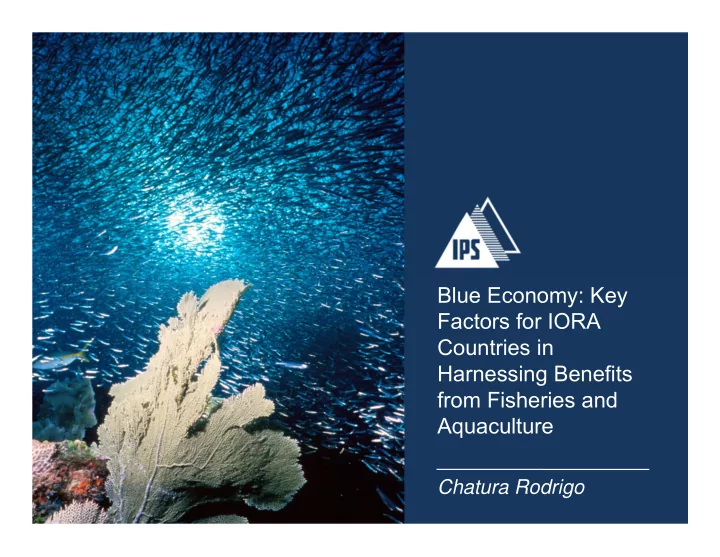

Blue Economy: Key Factors for IORA Countries in Harnessing Benefits from Fisheries and Aquaculture Chatura Rodrigo
Structure • Concept of blue economy and Why blue economy • Fish and aquaculture in Indian ocean • Production, Supply and Demand • Sustainability: major concerns • Way forward
Blued economy and why
Concept of Blue Economy Would help countries to: Blue economy is • Establish food security concentrated on : • Maintain sustainable livelihoods • Alleviation of • Promote Coastal hunger tourism • Poverty eradication • Explore renewable • Creation of energy sustainable • Extract Hydrocarbons livelihoods and ocean minerals • Mitigation of • Enhance global trade climate change through shipping and ports
Indian ocean is rich with fish and aquaculture resources. Countries are harvesting these resources extensively and support livelihoods and economies However, many factors such as over exploitation, technological constrains, sustainable harvesting, world market prices and climate change threaten these activities Hence the emphasis from “Green Economy “to “Blue Economy”
Fisheries and aquaculture in Indian ocean
Fisheries and Aquaculture in the Indian Ocean Fisheries: Spanish mackerel, Jack, Trevallies, Skipjack tuna, yellowfin tuna, Mackerel shark, Sword fish, Big eye tuna, Bullet tuna, Frigate tuna. Aquaculture: grass carp , silver carp , bighead carp , catla, mrigal, milkfish, giant tiger prawn
Source: State of world fisheries and aquaculture, FAO 2014
Source: Regional market assessment, Vincent and Hjort, 2013
Supply of fish and aquaculture in the Indian Ocean Constrains/weakness • Marine water is with warm Opportunities and Potential currents and narrow • Marine water is rich with continental plates, higher fuel capture fish species and costs, exploitation of small demand for Tuna is increasing dermasal and artisanal • Aquaculture: Increasing fisheries • Aquaculture: Low valued competition of Latin American countries. Potential to develop farmed fish, high production national markets cost, • Regional trade: high value • Recreational fish: Though the farmed fin fish are in demand for game fishing is competition, but oportunity is there the quality of fish is very there with increased low • Regional trade: transportation consumption rates cost impacts regional trade
Demand for fish and aquaculture in the Indian Ocean Characteristics of the demand • Diversity of countries in terms of national income: consumption is affected by • Income and middle income class growth • Population growth • Consumer awareness • Location (urban, rural, island factor) • Culture (religion, habits) • Some countries the consumption/demand is linked to the tourism sector therefore tourism sector development matters
Sustainability: Major issues
Sustainability of fish and aquaculture: major issues Over exploitation: (Immature catch, use of illegal equipment) • Property rights argument: Open access resource • Economy of scale argument: Large boats have the comparative advantage over small boats. Small boats spend more days for little catch • Transaction cost argument: Small boats have higher transaction costs in arranging a fishing effort • Opportunity cost argument: new markets appear which pushes fisherman to over exploit , in the short run, farmers are better off in supplying to the new market
Major issues…. Concern over fishing area • International demarcations are often violated • Small countries have little capacity to protect their fishing areas • International relations are at stake • Fisherman who commit illegal activities are worse off with fines, loss of family income and fishing gear when caught • Are all the crossing of boundaries intentional?
Major issues…. Technology transfer issues • Larger and countries with strong economies can adapt new technologies easily. Small countries are stuck with yesterdays news • How to finance new technology: small and poor countries are at a disadvantage. Lack of support form financial entities • Lack of government support : Some times private companies, specially exporters are on their own • Technology transfer through FDI’s: lack of policy conducive environment • Maintenance of standards becomes problematic: export, processing and catching
Major issues…. Research and development • Independent research and development vs lack of collaborations: latter is less • Research on demand, supply, price analysis, socio ‐ economic impacts are equally important as scientific research • Funds for research and development: small countries are at a disadvantage • Data sharing and information dissemination: more is needed
Major issues…. Climate change • Climate change will alter fish and aquaculture population growth, migration patterns, sex ratios, spread of diseases • More research is needed: to understand its impacts at country levels • Climate change has to be at the center of fisheries and aquaculture sector development plans for countries and regions • Fisherman are already adapting, there are lessons that policy makers can learn: there is a mismatch
Way forward
Way forward • Regulations and monitoring: boat licensing, fishing area management, record maintenance, fines • Economic instruments: Quotas on fish catch, subsidies on industry ( fuel, boats, technical equipments, community based aquaculture ) • Technology transfer ( fish catch, processing, navigation, communications, record keeping, post harvest ) • Information dissemination (quality standards, export markets, world prices, data) • Research (fish populations, fish migration patterns, high yielding aquaculture species, disease and cure for aquaculture diseases, demand changes, supply gaps, climate change)
Thank You
Recommend
More recommend